| Timer Function Code | Timer Function | Description | Diagram |
| 111 | On Delay
 | The timing period starts when the supply voltage is applied. After the pre-set time period has elapsed, the output relay ’R’ is energised. ’R’ Will stay energised until the supply is interrupted, if the supply is interrupted then ’R’ returns to its original state.Regardless of when this occurs the timer starts from the beginning of the cycle all over again. | 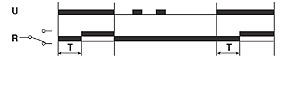 |
| 121 | On Delay (Control Switch
Resettable)
 | The timing period starts when the supply voltage is applied. The output relay ’R’ will energise after this period has elapsed, unless the control switch input ’S’ is repeatedly closed and then opened. The timer monitors the leading edges of the control switch pulses. Pulse length therefore has to be shorter than that of the timer period set. | 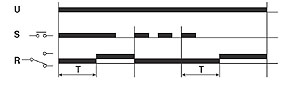 |
| 131 | On Delay (Control Switch
Interruptible) Type 1
 | The timing period starts when the supply is applied to the timer with the control
switch ’S’ open. Closing ’S’ causes the timer to pause its timing, without resetting.
Timing then resumes once ’S’ is opened again. Therefore the total time taken
for the output relay ’R’ to energise is the preset timing period plus the sum of the
time ’S’ was closed. Removal the supply will cause the timer to reset the timing
period back to the preset value. | 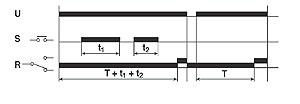 |
| 132 | On Delay (Control Switch
Interruptible) Type 2
 | The timing period starts when both the supply and control switch are energised. Opening the control switch suspends timing but does not reset the time sequence. Therefore, the total time taken before the delayed contact changes state is the pre set time plus any time that the control switch is open. Interrupting the supply resets the timer. If the control switch remains closed during and after the reset, timing will resume immediately the supply is resumed. | 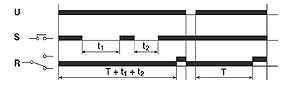 |
| 141 | On Delay (Constant Supply)
Type 1
 | A permanent supply is required. A control switch ’S’ is used to control the timer function. The delay period starts once switch ’S’ is closed.Once the preset time period has elapsed then output relay ’R’ energises. Opening ’S’will cause ’R’ to de-energise, and likewise closing it again will start the timing period from the beginning, this action may be performed at any point of the timing cycle. | 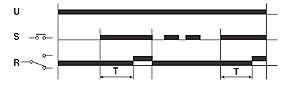 |
| 142 | On Delay (Constant Supply)
Type 2
 | Timing will commence when the supply is present and switch ’S’
is open. After the time period has elapsed, the output relay ’R’ will energise.
If however ’S’ is closed then the timing period resets to the beginning
of the cycle. Timing will restart only when ’S’ has been opened. Therefore
there are 2 methods this timer can be controlled, either by opening and closing ’S’
or with the interruption of the supply voltage to the timer with switch ’S’ open. | 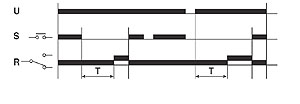 |
| 143 | On Delay ( Constant Supply)
Type 3
 | A permanent supply is required. The timing period starts when the control switch ’S’ is closed and will continue irrespective of any further changes to ’S’. After the elapsed time output relay ’R’ energises. To reset the timer, switch ’S’ must be opened. This does not de-energise the relay. It is de-energised and the function repeated when switch ’S’ is reclosed. (ie, the timer must see a leading edge). | 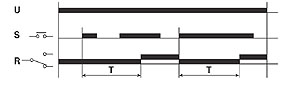 |
| 161 | On Delay with Instantaneous
Contact
 | The timing period starts when the supply voltage is applied. The output relay ’R’2
energises immediately. After the pre-set time period has elapsed, the output relay ’R’1
’R’1 and ’R’2 will stay energised until the supply is interrupted. If the supply is
interrupted ’R’1 and ’R’2 return to their original state. Regardless of when this occurs
the timer starts from the beginning of the cycle all over again. | 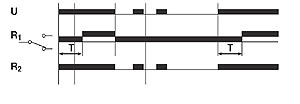 |
| 191 | On Off Delay (Constant
Supply)
 | A permanent supply is required. Control switch ’S’ controls the timer function. When
switch ’S’ is closed, the timer period starts. Once this has elapsed output relay ’R’ energises. If switch ’S’ is opened the relay remains energised for the same length of time as the first preset time period. Once this too has elapsed the relay de-energises and remains so until switch ’S’ is closed again. Closing switch ’S’ and then opening it before the time period has elapsed will not cause activation of ’R’. | 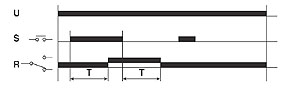 |
| 211 | Off Delay (Constant Supply)
Type 1
 | A permanent supply is required. The timer function is triggered by the use of control switch ’S’. When ’S’ is closed the output relay ’R’ will energise immediately. The timing period will start once ’S’ is opened, with ’R’ still energised. Once this period has elapsed then ’R’ will de-energise. Closing ’S’ at any time in the cycle will cause ’R’ to energise if it is not already and the timing period to start from the beginning. | 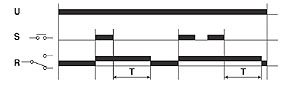 |
| 212 | Off Delay (Constant Supply)
Type 2
 | A permanent supply is required. The timer function is triggered by the use of control switch ’S’. When the switch is closed the output relay ’R’ will energise immediately.Once the timing period has started further actions of ’S’ will have no effect. However once the timing cycle has been completed the process may be started again by closing ’S’. While the timer is executing this function the only way to reset the timer is to interrupt the supply. | 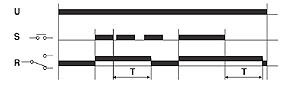 |
| 311 | True Off Delay
 | When the supply is applied the timer output relay ’R’ will energise. When the supply
is removed ’R’ will stay energised for the preset time period.Re-applying the supply
will cause ’R’ to energise again (if it is not already) and the timing period
starts when the supply is disconnected again. A point to note is that the timer needs
to store the energy to retain the output relay in the energised state after the supply
has been removed. This will reflect in the length of time the supply has to be applied. | 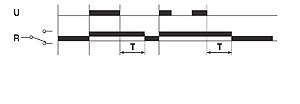 |
| 411 | Delayed Pulse (Constant
Supply)
 | The timing period starts when the supply is applied to the timer. After the preset
has elapsed the output relay ’R’ will energise for the preset pulse duration.
To reset the timer the supply has to be interrupted. If this interruption occurs
during the pulsed output then the relay will de-energise and the timer
will reset. (’T’ is the delay duration and ’t’ is the pulse duration). | 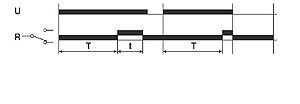 |
| 412 | Delayed Pulse (Remote
Trigger)
 | The timing period will start when control switch ’S’ is closed with the
supply connected. After preset time has elapsed the output relay ’R’ will energise
for the pre-selected pulse duration. To reset the timer either control switch ’S’ is open
or the supply has to interrupted. If this action occurs during the pulsed output
cycle then the relay will de-energise and the timer will reset. (’T’ is the delay
duration and ’t’ is the pulse duration). | 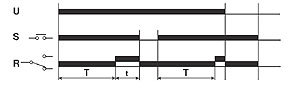 |
| 413 | Delayed Pulse (Constant
Supply) Type 1
 | Supply to the unit must be continuous. On closure of the ’S’ the time period ’t1’ starts to run.On
completion of ’t1’, the relay ’R’ energises immediately and the time period ’t2’ starts to run. On
completion of ’t2’ the relay ’R’ de-energises. The control contact ’S’ has no effect until ’t1’ + ’t2’ have
completely expired. | 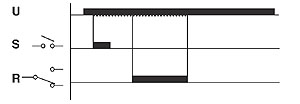 |
| 414 | Delayed Pulse (Constant
Supply) Type 2
 | The supply is connected permanently to the timer. A switch ’S’ is used to control
the timer function (refer to the timing diagram). The delay time period starts closing
After elapse of time set the output relay ’R’ is energised for a fixed period T2.
Opening switch ’S’ during time period ’T’ has no affect, but re-closing will initiate
timing ’T’ once more. | 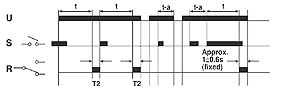 |
| 421 | On Pulse
 | When the supply is connected the output relay ’R’ energises and the timing function starts. After the preset timer period has elapsed ’R’ de-energises. Interrupting the supply resets the time period. If this interruption occurs before the period has elapsed ’R’ will de-energise the timing period resets. | 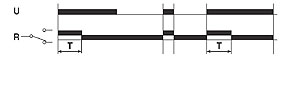 |
| 431 | On Pulse (Control Switch
Resettable)/Watchdog
 | Output relay ’R’ will energise as soon as the supply is applied to the timer if control switch ’S’ closed, and will start to time out unless control switch ’S’ opened and then closed repeatedly within the time period. The timer will not time out while it sees a continuous series of pusles. If ’R’ does de-energise, then the timer can be reset by closing control switch ’S’ and repeating the process as before. | 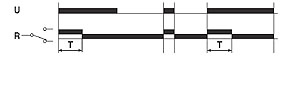 |
| 432 | On Pulse (Supply Reset)
 | On application of supply voltage the relay energises. The first pulse of ’S’ starts the time period. Receiving pulses during the time period extends it and ’R’ stays energised.Receiving no pulses during the time period completes it and ’R’ de-energises. ’R’ stays latched until supply voltage has been interrupted. | 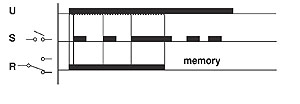 |
| 441 | On Pulse (Control Switch
Interruptible)
 | When the timer supply is connected output relay ’R’ energises and the timer period starts. If control switch ’S’ is closed then the timing is suspended. Only when ’S’ is open again will the timing resume. Therefore the total time output relay ’R’ is energised is equal to the preset time period plus the sum of the time ’S’ is closed. Interrupting the supply will reset the timer. | 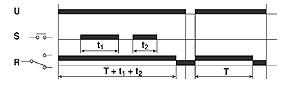 |
| 451 | On Pulse (Constant Supply)
Type 1
 | A permanent supply is required. Control switch ’S’ controls the timers function. When ’S’ is closed output relay ’R’ energises and will then time out irrespective of any further action of ’S’. To reenergise ’R’, ’S’ must be opened and then closed after ’R’ has de-energised. | 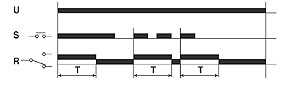 |
| 452 | On Pulse (Constant Supply)
Type 2
 | A permanent supply is required. Control switch ’S’ controls the timers function. When ’S’ is opened output relay ’R’ energises and will then time out irrespective of any further action of ’S’. To reenergise ’R’, ’S’ must be closed and then opened after ’R’ has de-energised. | 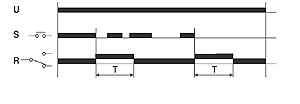 |
| 453 | On Pulse (Constant Supply)
Type 3
 | A permanent supply is required. Control switch ’S’ controls the timers function. When ’S’ is closed and remains closed the output relay ’R’ will energise and only de-energise after it has timed out. If ’S’ is opened during the timing period relay ’R’ resets. | 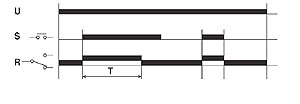 |
| 454 | On Pulse (Constant Supply)
Type 4
 | A permanent supply is required. Control switch ’S’ controls the timers function. When ’S’ is opened and remains open the output relay ’R’ will energise and only de-energise after it has timed out. If ’S’ is closed during the timing period relay ’R’ resets. | 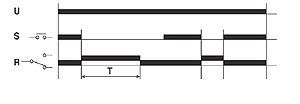 |
| 511 | Off Pulse
 | A permanent supply is required. Control switch ’S’ controls the timers function. Closing control ’S’ has no effect on output relay ’R’. However when ’S’ is opened ’R’ will energise and starts the time period, after which it will de-energise. If switch ’S’ is pulsed during that timing period it will have no effect on relay ’R’. Closing and then re-opening ’S’ will repeat the timing operation after the completion of the timing period. | 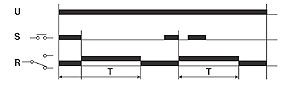 |
| 521 | On Off Pulse
 | A permanent supply is required. Control switch ’S’ controls the timers function. The output relay ’R’ is energised by either opening or closing control switch ’S’. Once a timing period has started it cannot be interrupted by changing the state of ’S’. | 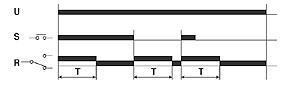 |
| 611 | Symmetrical Recycler Pulse
Start
 | When the supply is connected to the timer it will energise the output relay ’R’ for the preset time and then de-energise for the same preset time interval. This operation will repeat indefinitely until the supply is removed. The timer will always start at the same point of the cycle regardless of where it was when the supply was removed. The unit can be either pause or pulse start depending on wiring or type. | 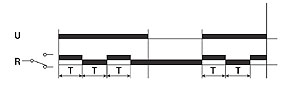 |
| 612 | Symmetrical Recycler Pause
Start
 | When the supply is connected to the timer the preset time will elapse before output relay "R" energises for the same preset time interval. This operation will repeat indefinitely until the supply is removed. The timer will always start at the same point of the cycle regardless of where it was when the supply was removed. The unit can be either pause or pulse start depending on wiring or type. | 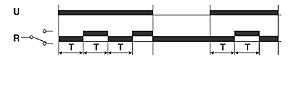 |
| 651 | Asymmetrical Recycler Pause
Start
 | When the supply is connected to the timer the first preset time will elapse before the output relay ’R’ will energise. The output will stay energised for the second preset time period (which is set independently to the de-energised time) it will return to the de-energised state and repeat the whole process over again. This is continued until the supply is removed. The timer will always start in the de-energised part of the cycle regardless of which state it was in when the supply was removed. | 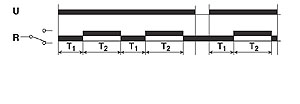 |
| 652 | Asymmetrical Recycler Pulse
Start
 | When the supply is connected to the timer the output relay will energise for the first preset time. Once this has elapsed the output will de-energise and stay de-energised for the second preset time period (which is set independently to the energised time). Once this has elasped then it will return to the energised state and repeat the whole process over again, until the supply is removed. The timer will always start in the energised part of the cycle regardless of which state it was in when the supply was removed. | 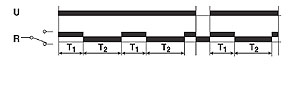 |
| 661 | Asymmetrical Recycler
(Constant Supply) Pause Start
 | A permanent supply is required. The timer function is triggered by the use of a control switch ’S’. When ’S’ is closed the output relay ’R’ will remain de-energised while the first preset time period elapses. Once this time period has elapsed ’R’ will energise for the second preset time period (which is set independently). Once this second time period had elapsed then ’R’ will de-energise and the cycle will start from the beginning again.If ’S’ is opened the cycle will stop, with it starting in the deenergised state when the switch is closed again. | 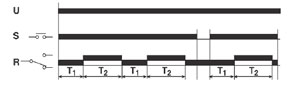 |
| 662 | Asymmetrical Recycler
(Constant Supply) Pulse Start
 | A permanent supply is required. The timer function is triggered by the use of a control switch ’S’. When ’S’ is closed the output relay ’R’ will energise while the first preset time period elapses. Once this time period has elapsed ’R’ will de-energise for the second preset time period (which is set independently). Once this second time period had elapsed then ’R’ will energise and the cycle will start from the beginning again. If ’S’ is opened the cycle will stop, with it starting in the energised state when the switch is closed again. | 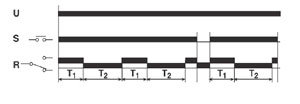 |
| 711 | Star Delta Type 1
 | This function of a timer has 2 sets of normally open contacts. The timing period starts when the supply is connected. At this point the first output relay ’R1’ will energise. This is used to control the ’STAR’ contactor. After the preset time interval the contacts will open. A preset dwell time will elapse after which the second output relay ’R2’ will close. | 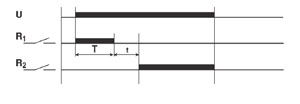 |
| 712 | Star Delta Type 2
 | This type of timer uses 2 sets of contacts. One being normally open and the other is normally closed. Alternatively 2 sets of change over contacts may be used. The timing
period starts when the supply is applied. After the preset interval has elapsed the normally closed contact will energise opening the circuit. This is used to control the ’STAR’ contactor. After the preset dwell time has elapsed the normally open contacts will close, this is used to control the DELTA contactor. The timer will reset itself when the supply is removed. (’t’ is the dwell time). | 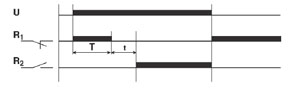 |
|
 | |  |



































